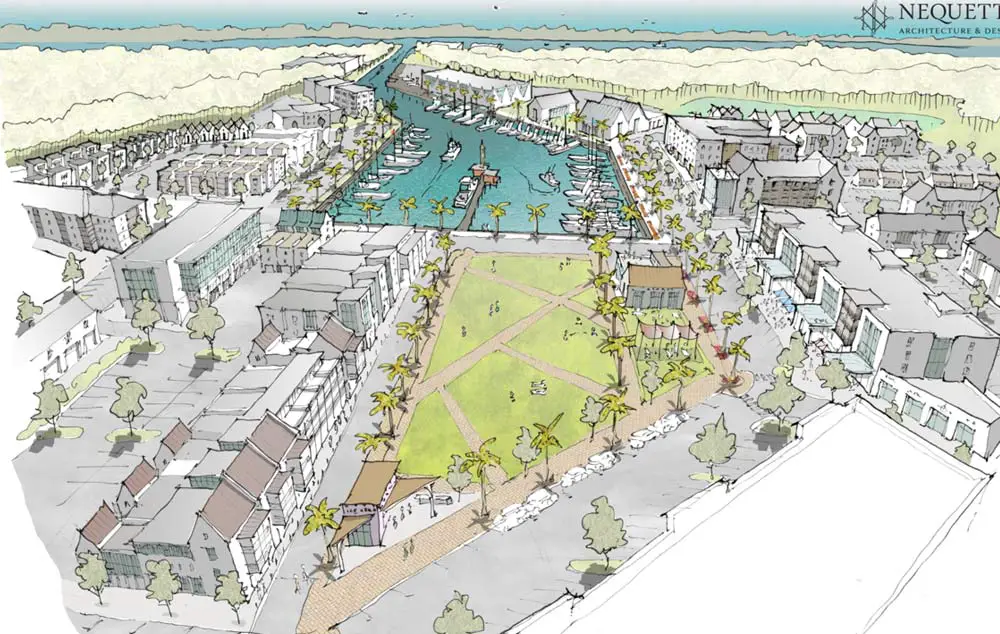
The Palm Coast City Council approved doubling the allowable housing units at what will be called Lighthouse Harbor at Marina Village on Colbert Lane, to 845 homes and apartment units, and reducing commercial and retail space there by 57,500 square feet, to just over 100,000 square feet.
The council approved several deviations from the Land Development Code to accommodate the developer, which is part of the Marina Village collection of developments. Between Marina del Palma’s 615 units to its immediate north and a 240-unit apartment complex immediately to the west of Colbert Lane, the cluster of new developments will add 1,400 housing units.
The combined population of the development would equal that of present-day Bunnell. It would also create, in the developers’ vision, a new, walkable community attractive to its own residents as well as residents from across the county and beyond.
The 4-1 vote last week was on the first reading of the ordinance. The proposal won’t be finally approved until a second reading of the ordinance net month. The council’s David Alfin, Ed Danko, Cathy Heighter and Nick Klufas voted in the majority, with Theresa Pontieri in dissent, but only to the extent that she is awaiting some refinement of the plans before the ordinance’s second reading.
Marina Village sits on both sides of Colbert Lane, just south of Marina del Palma and west of Boston Whaler manufacturing, what used ton be Sea Ray Boats. The cobble of eight parcels within Marina Village has changed hands a few times over the years, with seven parcels east of Colbert now part of Lighthouse Harbor, and the parcel west of Colbert owned autonomously, with the apartment complex there under construction. Lighthouse Harbor apartments’ owners got their development order last spring.
“It’s always been the intent of the county and city that this become a sort of an urban mixed-use center that would be not only for the residents there but for the public and the citizens of Palm Coast,” Michael Chiumento, the land-use attorney representing the developer, told the council. He was with Doug Jeffords, the chief construction officer with Home Communities Company, which would build the project.
Lighthouse Harbor would be open to the public, its spaces conducive to public events. Chiumento’s description of the proposed development brings to mind a more open European Village, with water access. “Not only the residents but the entire Flagler County public and some of our visitors” would go there, Chiumento said, “and create an opportunity for some tourism also.”
“It’s important to emphasize the quality and the vision behind this project,” Klufas said. “This is a tremendous project and it’s going to be really complimentary to the development to the north. And I think it’s just on us to have the communication with the public to let them know that, although this may be an upward number in total units, that this is still the vision and this is a high quality product that’s going to be produced.”
Pontieri had no issues with the project, conceptually. She has objected to reductions in commercial spaces, but in this case she had no objection to that. She had two objections, however. First, she was concerned about diversions from the Land Development Code, as she was in the same meeting regarding a different development (Belle Terre Estates in Seminole Woods).
Second, she recalled her concerns over the Harborside development a divided council approved in Februaryy, amid much controversy, in part by giving in to the developer on such divergences.
“This vision is nothing but a hole with water in it and residential units surrounding it with maybe some commercial somewhere mixed in,” Pontieri said. “And I get it, there’s property rights and all of those things but as we’re looking to reduce the commercial and grant the extra residential, I think that we also need to make sure that the integrity of what we’re actually looking at, holds true.”
For example, current conceptual plans include a vast green plaza-like space that would accommodate public events and leisurely public strolls. But nothing in the plans require the developer to stick to that plan. “This green space could very well go away. Am I wrong?” she asked. She had the same questions about other components, including the restaurant and possible hotel, and asked that the town homes abide by the city’s development code rather than have their dimensions shrunk.
Ray Tyner, the city’s planning director, said he could secure stronger assurances from the developer before the ordinance’s second reading.
Read Related Also: Mom heard repeatedly saying ‘bye’ to baby’s dad after fatally shooting him in their home gets 5 years in prison
What used to be the Lehigh Cement Plant for decades after the early 1950s was acquired by Palm Coast Holdings in 2004. Marina Village was a planned unit development originally approved by Flagler County government in 2006, with a 2008 amendment that cleared the way for 160,500 square feet of commercial development, 511 residential homes, and a marina with 80 wet slips and 200 dry boat storage spaces.
After the land was annexed into Palm Coast, the city approved expanding the number of housing units to 663 in 2019. In May 2021, Jeffrey Gelman’s Colbert lane Development bought the 22-acre parcel west of Colbert Lane from Jim Cullis’s Lighthouse Harbor for $1 million and last April secured a development order to build a 240-apartment complex there.
Lighthouse Harbor then sold the land on the east side of Colbert Lane to Birmingham, Ala.-based Lighthouse Palm Coast Holdings LLC in June 2022 for $8.5 million. That company plans to develop what would be called Lighthouse Harbor, a high-density mixed-use pedestrian-friendly community, with the marina as its focal point. That’s the proposal the council approved last Tuesday.
Since the apartment complex accounted for 240 housing units, that dropped the allowable (or vested) units east of Colbert Lane to 423 homes. Those are vested. To go up to 845 homes, the developer had to win the council’s approval. It did so, along with several exceptions to the Land Development Code.
The minimum allowable lot size for a town home is 2500 square feet. The developer requested for a reduction to 2,000 square feet. The maximum height for town homes is 35 feet. The developer asked for an increase to 45 feet, also requesting a reduction in townhome setbacks from 25 feet to 20 feet. The allowable apartment-building height was to be 95 feet. The developer is dropping that to 60 feet.
City code requires that 30 percent of apartments and town homes have garages. The developer is requesting an exception to that, proposing to build car ports instead, similar to those at the apartment complex along Bulldog Drive in Palm Coast.
Actual construction would begin at the marina, then expand outward in a clockwise direction. There would be a yacht club with a restaurant and possibly a hotel, residential homes or apartments, some commercial uses, and so on. “This is not commercial uses for big boxes, or even medium sized boxes that you see,” Chiumento said, describing the future businesses more as boutiques and services pertinent to the public and a marina environment. His client, he said, “came up with the opinion that this mix and change is necessary in order to make the commercial uses viable in the long term and consistent with the concept of a marina neighborhood village.”
The next step will be construction of sea walls, building the boat-storage facility, and partnering with marina operators, then construction of the apartments and retail space at the southern edge of the basin. That portion’s permits are in place, except for the fuel-tank permit. That would be secured in the future.
The sea wall reference drew a question from Alfin: will the basin handle flood surges in serious storms? Jeffords said the sea walls will account for that.
Marina Del Palma is an autonomous development adjoining Marina Village to the north. The City Council approved the 106-acre development, which is well on its way, in December 2017, for 154 single family homes on 40-foot-wide lots on the western portion of the acreage, 461 apartment units built to a height of up to 95 feet on the eastern portion of the acreage, and a marina with a boat-storage facility that will rise up to 70 feet. Marina del Palma is approved for 46,000 square feet of commercial development.
A public participation meeting at the Hilton Garden Inn on July 10, regarding Lighthouse Harbor’s plans, drew some 10 residents already living at Marina del Palma. Their key concern was how Lighthouse Harbor would affect their own properties. “They were happy they were getting a 10-foot buffer they didn’t have before,” Senior Planner Bill Hoover said. “They knew the project’s going to get developed some time because it’s already approved. So they’re really not getting anything too much different except that the applicant is requesting more residential units than they had before, and dropping commercial.
The Planning Board heard the proposal in July. The item drew no public response. The board recommended approval by a 7-0 vote. Should the council approve the proposal on second reading, the final plat proposal would still have to be approved by the City Council in the future. Any apartment units that are not townhomes would be reviewed administratively as technical site plan–not by the Planning Board, not by the Council–unless the request is for 40 apartment units or more. In that case, the plan goes before the Planning Board. If the request exceeds 100 units, it goes before the City council.
![]()









